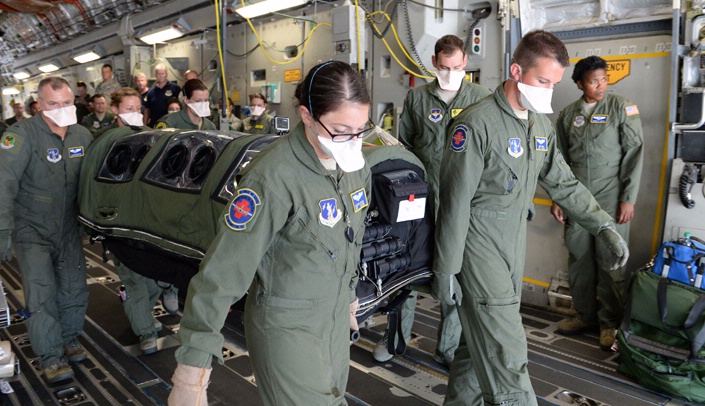The Nebraska Biocontainment Unit (NBU) teamed with the U.S. Air Force last month to simulate the transport of patients with dangerous infectious diseases, using two of the latest models in long distance biocontainment transport units.
Brig. Gen. Kory Cornum, M.D., the Air Mobility Command surgeon and his team, as well as two ambulance companies, joined forces with NBU personnel to hold the drill at Offutt Air Force Base, which simulated the transportation of patients with diseases such as Ebola to Omaha.
The patient units are designed to contain hazardous microbes while providing care to multiple patients during transport.
About the units
The GENTEX Patient Isolation Unit (PIU), the next generation of isolation units, is a single-use, 7-foot-long portable structure that can fit one patient up to 6 1/2 feet tall. The unit seals and secures the patient inside with all medical monitoring equipment. Three HEPA filters exchange the air 12 times an hour. Doctors can treat the patient through 13 access ports. A patient can be contained in this unit for up to 12 hours.
The Transport Isolation System is a three room, steel-framed biocontainment unit that can hold up to four patients at a time, depending on the degree of their illness. The Critical Care Air Transport Team can provide care while in full personal protective gear (PPE).
After the Ebola outbreak in 2014, the Department of Defense decided that the military needed to be ready to evacuate multiple contaminated patients, such as soldiers, if another large outbreak occurred.
The military policy was to treat people where they were, but since treatment units don’t have the facilities to treat U.S. troops in Africa for Ebola the plan has changed to get soldiers back safely.
The military purchased 25 of the containment systems for $7 million. Three are now assembled and the rest will be ready in the next four months. They will be stationed strategically around the world and can be fitted into any C-17 or C-130 transport planes.
After the media show-and-tell, the drill began. The scenario, one patient with an unknown and potentially infectious upper respiratory infection was being transported to Nebraska Medicine. The patient, a mannequin in the Patient Isolation Unit (PIU), was carried down the plane’s large ramp to a gurney, and four medics from the Omaha Fire Department and Midwest Medical Transport waiting in full personal protective equipment (PPE).
During the training drill, after the first patient was safely in the ambulance, two passengers unexpectedly began coughing and showing early signs of disease symptoms instantly turning the scenario into a multiple patient transport.
Masks were placed on the second and third high-risk exposure patients and they were isolated from the crew until EMS medics escorted them from the plane and onto separate ambulances.
A convoy of three ambulances, escorted by a Douglas County Sherriff’s SUV and two chase vehicles, travelled to Nebraska Medicine. From there, the NBU staff took over and cared for the patients.
Phil Smith, M.D., medical director of the NBU and professor in the UNMC College of Public Health, said: “It was an honor for the Nebraska Biocontainment Unit to work with the military and local EMS in the transport drill. Preparedness requires collaboration between many different entities, and that was very evident during this drill.”
Following the drill, the NBU, EMS and military personnel involved in the drill participated in a “hot wash,” or debriefing, led by decontamination and transportation expert John Lowe, Ph.D., assistant professor of environmental, agricultural and occupational health, UNMC College of Public Health.
The group agreed the successful drill was dynamic and complex, that the military and civilian groups were flexible and were able to adapt to unplanned obstacles and different situations.
Communication seemed to be the big lesson of the day — direct communication between the ambulance units and especially between medics and the aircraft crew. This was critical when the second and third patients began to show symptoms of infection.
